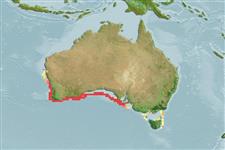>
Tetraodontiformes (Puffers and filefishes) >
Monacanthidae (Filefishes)
Etymology: Eubalichthys: Greek, eu = good + Greek, baleo, ballo = to throw + Greek, ichthys = fish (Ref. 45335).
Environment: milieu / climate zone / depth range / distribution range
экология
морской демерсальный; пределы глубины 135 - 165 m (Ref. 9563). Subtropical
Eastern Indian Ocean: Australia (southern Western Australia and South Australia).
Size / Вес / Возраст
Maturity: Lm ? range ? - ? cm
Max length : 40.0 cm TL самец/пол неопределен; (Ref. 9563)
Occurs on the continental shelf (Ref. 9563). Minimum depth from Ref. 58018.
Life cycle and mating behavior
Maturities | размножение | Spawnings | Egg(s) | Fecundities | личинки
May, J.L. and J.G.H. Maxwell, 1986. Trawl fish from temperate waters of Australia. CSIRO Division of Fisheries Research, Tasmania. 492 p. (Ref. 9563)
Статус Красного Списка МСОП (Ref. 130435)
Угроза для людей
Harmless
Использование человеком
дополнительная информация
инструменты
Специальные отчеты
Скачать в формате XML
ресурсы в Интернет
Estimates based on models
Preferred temperature (Ref.
123201): 14 - 16.5, mean 14.7 °C (based on 4 cells).
Phylogenetic diversity index (Ref.
82804): PD
50 = 0.5156 [Uniqueness, from 0.5 = low to 2.0 = high].
Bayesian length-weight: a=0.01995 (0.00943 - 0.04220), b=2.93 (2.75 - 3.11), in cm total length, based on LWR estimates for this (Sub)family-body shape (Ref.
93245).
Trophic level (Ref.
69278): 2.8 ±0.4 se; based on size and trophs of closest relatives
устойчивость к внешним воздействиям (Ref.
120179): средний (среднего размера), минимальное время удвоения популяции 1.4-4.4 года (Preliminary K or Fecundity.).
Fishing Vulnerability (Ref.
59153): Low to moderate vulnerability (30 of 100).
